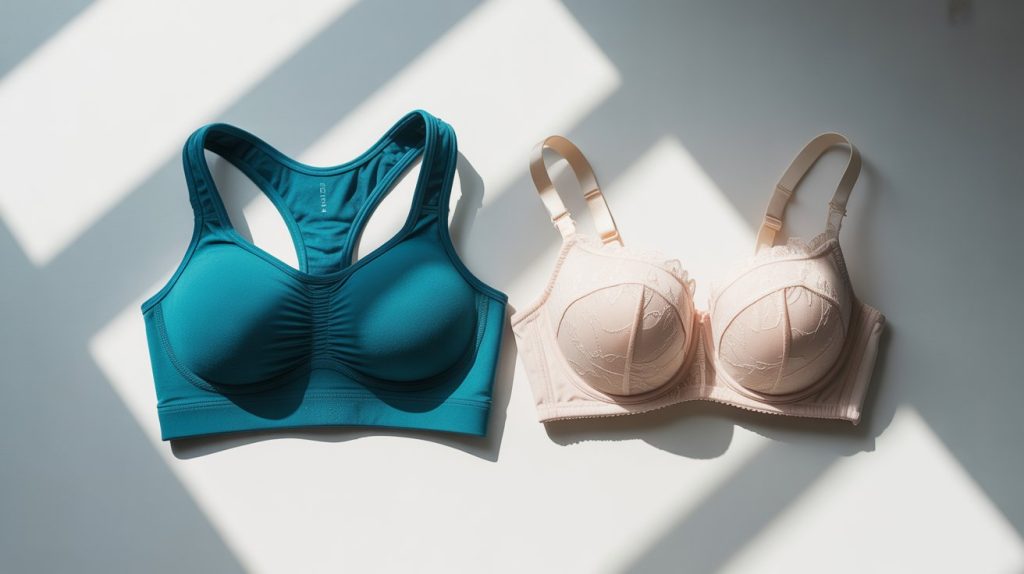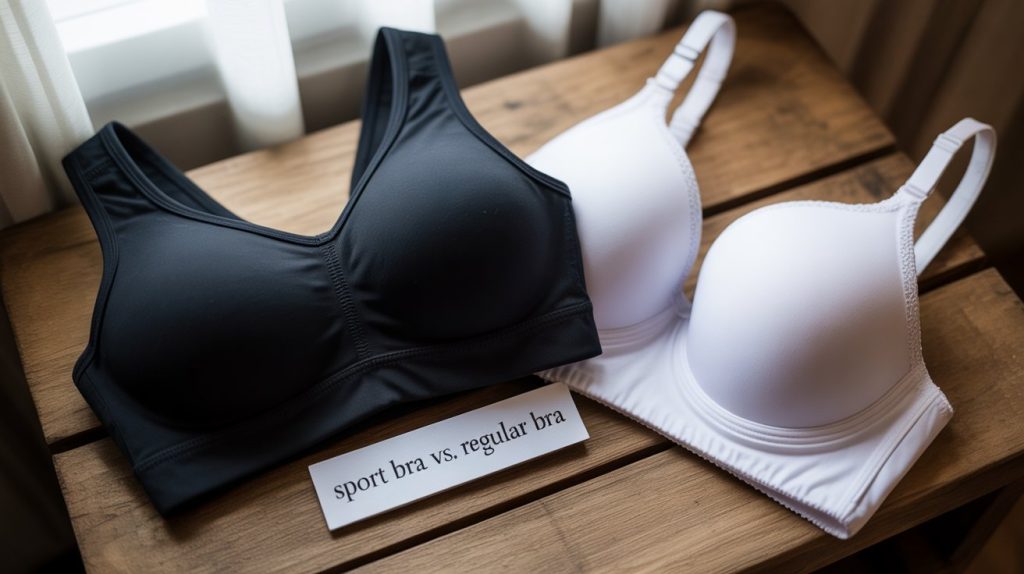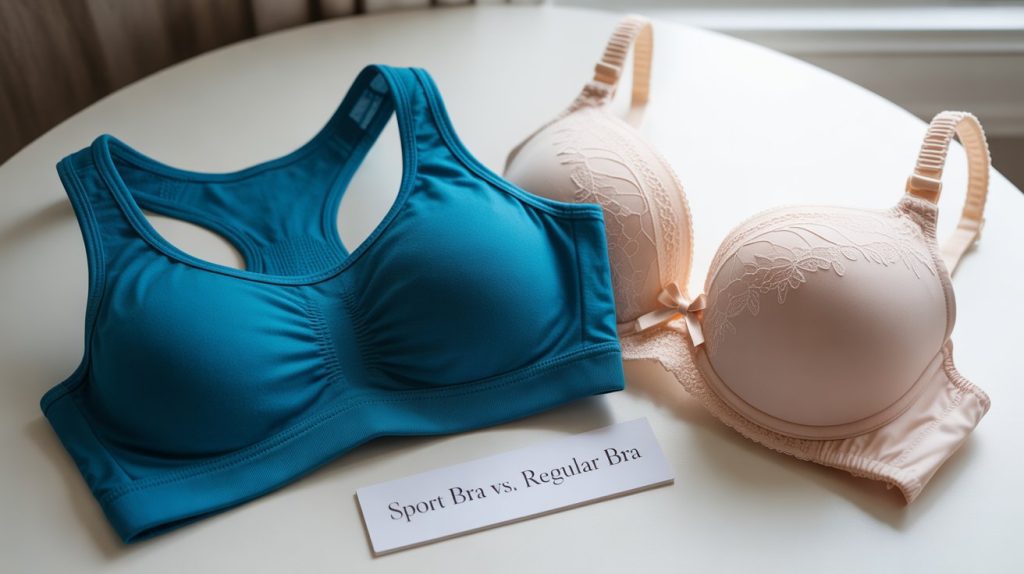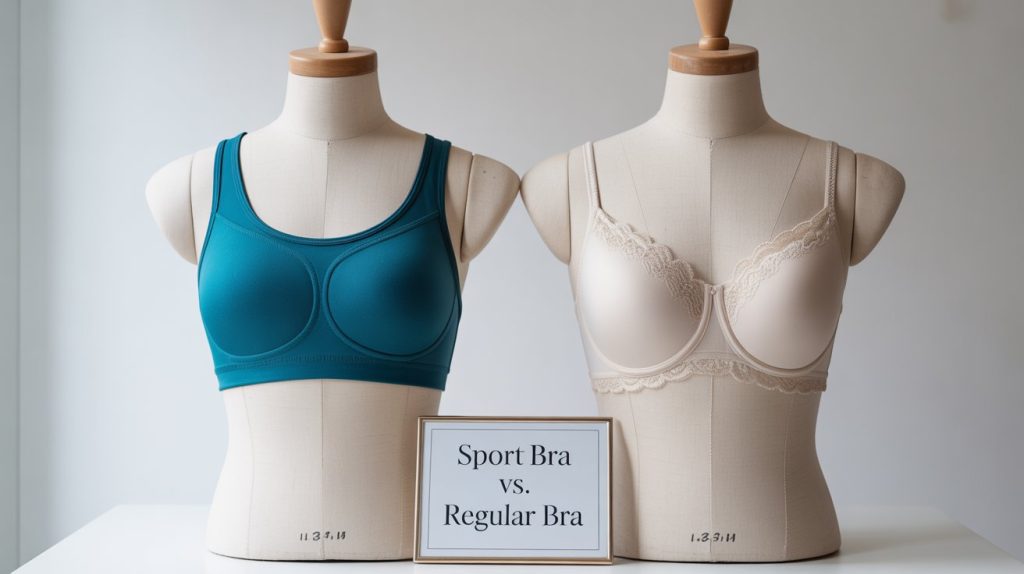Sport Bra vs. Regular Bra – Understanding the Differences and Choosing the Right One for You
When it comes to choosing the right bra, the decision between a sport bra and a regular bra can make a significant impact on your comfort, support, and performance. While both types of bras serve the essential function of supporting your breasts, they are designed with different purposes, activities, and features in mind. We’ll explore the key differences between sport bras and regular bras, dive into their unique benefits, and provide practical tips to help you choose the perfect bra for your lifestyle.
What Is a Sport Bra?
A sport bra is a specialized type of bra designed to provide maximum support, reduce breast movement, and enhance comfort during physical activities such as running, yoga, or weightlifting. Unlike regular bras, sport bras are engineered to handle the increased motion and impact associated with exercise, making them an essential piece of athletic wear for anyone engaging in sports or high-energy activities.
Key Features of Sport Bras
- High Support: Sport bras are designed to minimize breast bounce, which can reduce discomfort and prevent long-term tissue damage during exercise.
- Moisture-Wicking Fabrics: Most sport bras are made from breathable, moisture-wicking materials like polyester or spandex blends to keep you dry during workouts.
- Wide Straps and Bands: These provide extra stability and distribute pressure evenly, preventing digging or slipping.
- Compression or Encapsulation: Sport bras use compression (pressing breasts against the chest) or encapsulation (supporting each breast individually) to reduce movement.
- Minimal Seams: Seamless or flat-seam designs reduce chafing and irritation during intense activities.
Sport bras come in various styles, such as pullover, racerback, or adjustable-strap designs, and are categorized by impact level (low, medium, high) to suit different activities.
What Is a Regular Bra?
A regular bra is designed for everyday wear, providing support, shaping, and comfort for daily activities like work, socializing, or lounging. Regular bras come in a wide variety of styles, such as T-shirt bras, push-up bras, or balconette bras, and prioritize aesthetics and versatility alongside support.
Key Features of Regular Bras
- Variety of Styles: Regular bras are available in styles like padded, underwire, wireless, or strapless, catering to different outfits and preferences.
- Aesthetic Focus: Many regular bras feature decorative elements like lace, embroidery, or bright colors to enhance appearance.
- Moderate Support: Regular bras provide sufficient support for daily activities but are not designed for high-impact movements.
- Comfort for All-Day Wear: Soft fabrics like cotton or modal blends are common, prioritizing comfort over performance.
- Adjustable Features: Most regular bras have adjustable straps and multiple hook-and-eye closures for a customizable fit.
Regular bras are ideal for non-athletic settings but may not offer the stability or durability needed for intense physical activity.
Sport Bra vs. Regular Bra: Key Differences

The primary difference between a sport bra and a regular bra lies in their purpose and design. Sport bras are built for performance, focusing on support and stability during exercise, while regular bras prioritize comfort, versatility, and aesthetics for everyday wear. Here’s a detailed comparison to highlight their differences:
1. Purpose
- Sport Bra: Designed for physical activities, sport bras aim to reduce breast movement, prevent discomfort, and support performance during exercise.
- Regular Bra: Intended for daily wear, regular bras focus on comfort, shaping, and enhancing appearance for various outfits and occasions.
2. Support Level
- Sport Bra: Offers high support to minimize bounce, with options for low, medium, or high-impact activities. For example, a high-impact sport bra is ideal for running, while a low-impact one suits yoga.
- Regular Bra: Provides moderate support suitable for daily tasks but may not be sufficient for vigorous activities, as it’s not designed to control excessive breast movement.
3. Materials
- Sport Bra: Uses moisture-wicking, breathable fabrics like polyester, spandex, or nylon to manage sweat and keep you cool during workouts.
- Regular Bra: Often made with softer materials like cotton, modal, or lace for comfort and aesthetic appeal, but these may not wick moisture as effectively.
4. Design and Structure
- Sport Bra: Features wide straps, reinforced bands, and seamless or flat-seam construction to prevent chafing and ensure stability. Many have racerback or compression designs.
- Regular Bra: Includes decorative elements, underwires, or padding for shaping and style. Straps and bands are typically narrower and less robust.
5. Fit and Comfort
- Sport Bra: Fits snugly to hold breasts securely in place, sometimes feeling tighter than a regular bra. Compression styles may feel more restrictive but offer maximum support.
- Regular Bra: Prioritizes a comfortable, less restrictive fit for all-day wear, with adjustable features to accommodate daily activities.
6. Versatility
- Sport Bra: Primarily designed for exercise, though some styles can double as casual wear or crop tops. Less versatile for formal or dressy outfits.
- Regular Bra: Highly versatile, with styles suited for everything from casual T-shirts to evening gowns.
7. Durability
- Sport Bra: Built to withstand frequent washing and intense use, with durable materials that maintain elasticity over time.
- Regular Bra: May wear out faster if used for exercise, as the materials and construction are not designed for high-impact activities.
When to Choose a Sport Bra
A sport bra is the best choice when engaging in physical activities, whether you’re hitting the gym, going for a run, or practicing yoga. Here are some scenarios where a sport bra shines:
- High-Impact Activities: Running, HIIT, or aerobics require a high-impact sport bra to minimize bounce and provide maximum support.
- Medium-Impact Activities: Cycling, skiing, or dance classes benefit from medium-impact sport bras that balance support and flexibility.
- Low-Impact Activities: Yoga, Pilates, or walking call for low-impact sport bras that offer light support and comfort.
- Sweaty Workouts: Moisture-wicking fabrics in sport bras keep you dry during intense sessions.
- Athleisure Looks: Some sport bras are stylish enough to wear as crop tops or under open-back shirts for a sporty, casual vibe.
When to Choose a Regular Bra
A regular bra is ideal for everyday wear and situations where aesthetics, versatility, or light support are priorities. Consider a regular bra for:
- Daily Wear: T-shirt bras or wireless bras are perfect for work, school, or casual outings.
- Formal Occasions: Strapless or push-up bras complement dresses or evening wear.
- Low-Activity Days: If you’re lounging or engaging in minimal physical activity, a regular bra provides sufficient comfort.
- Fashion-Focused Outfits: Lace or embellished bras add a decorative touch under sheer or low-cut clothing.
How to Choose the Right Sport Bra

Selecting the right sport bra depends on your activity level, body type, and personal preferences. Here’s a step-by-step guide:
1. Determine Your Activity Level
- Low-Impact: Yoga, walking, or stretching requires light support. Look for soft, stretchy sport bras with minimal compression.
- Medium-Impact: Cycling, hiking, or dance classes need moderate support. Choose a bra with a balance of compression and encapsulation.
- High-Impact: Running, jumping, or HIIT workouts demand maximum support. Opt for a high-impact bra with strong straps and a snug band.
2. Measure Your Size
Sport bras use the same sizing system as regular bras (e.g., 34C, 36D). Measure your band size (underbust) and bust size, then calculate the cup size based on the difference. Refer to the brand’s sizing chart, as sport bra sizes can vary slightly.
3. Consider the Fit
- Band: Should be snug but not constricting, providing most of the support.
- Cups: Should fully encase your breasts without spillage or gaping.
- Straps: Should stay in place without digging into your shoulders. Adjustable or racerback straps offer extra stability.
4. Choose the Right Style
- Compression Bras: Press breasts against the chest, ideal for smaller cup sizes or low-to-medium-impact activities.
- Encapsulation Bras: Support each breast individually with molded cups, suitable for larger cup sizes or high-impact activities.
- Combination Bras: Combine compression and encapsulation for versatile support.
5. Test for Comfort
Try on the sport bra and move around—jump, stretch, or jog in place—to ensure it stays secure and feels comfortable. Check for chafing, pinching, or slipping.
How to Choose the Right Regular Bra
Finding the perfect regular bra involves considering your daily activities, body shape, and wardrobe needs. Here’s how to choose:
1. Identify Your Needs
- Everyday Comfort: T-shirt or wireless bras are great for all-day wear.
- Shape and Lift: Push-up or balconette bras enhance cleavage and create a rounded silhouette.
- Special Occasions: Strapless or plunge bras work well under specific outfits.
2. Measure Your Size
Measure your band and bust size as described earlier. Regular bras follow the same sizing system (e.g., 34B, 36C), but fit can vary by brand or style.
3. Check the Fit
- Band: Should sit parallel to the ground and provide most of the support. It should feel snug but not tight.
- Cups: Should fit smoothly without spillage (too small) or gaping (too large).
- Center Gore: The center part between the cups should lie flat against your sternum.
- Straps: Should be adjusted for light support without digging or slipping.
4. Match to Your Wardrobe
Choose a bra style that complements your clothing. For example, a seamless T-shirt bra is ideal for fitted tops, while a strapless bra works under off-shoulder dresses.
5. Try Different Styles
Experiment with styles like padded, underwire, or minimizer bras to find what suits your breast shape and comfort preferences.
The Importance of Breast Shape in Bra Selection
Breast shape affects how both sport bras and regular bras fit. Common breast shapes include:
- Teardrop: Fuller at the bottom, narrower at the top. Balconette or encapsulation sport bras work well.
- Round: Evenly full at the top and bottom. Most bra styles, including T-shirt and compression sport bras, suit this shape.
- East-West: Breasts point outward. Plunge or racerback bras help center the breasts.
- Asymmetrical: One breast is larger. Padded or adjustable bras can balance the appearance.
- Pendulous: Breasts hang lower. Full-coverage or high-impact sport bras provide lift and support.
Understanding your breast shape helps you choose bras that enhance comfort and fit, whether for exercise or daily wear.
Caring for Sport Bras and Regular Bras

Proper care extends the life of both sport bras and regular bras. Here are some tips:
- Wash Gently: Hand-wash with mild detergent in cold water or use a lingerie bag on a delicate machine cycle.
- Air-Dry: Avoid dryers, as heat can damage elastic and underwire. Lay bras flat or hang them to dry.
- Rotate Bras: Alternate between multiple bras to prevent overstretching. Aim for 3-4 bras in regular rotation.
- Store Properly: Fold bras with cups nested together to maintain their shape. Avoid turning cups inside out.
Sport bras may require more frequent washing due to sweat, so invest in durable, high-quality options.
Common Signs of an Ill-Fitting Bra
Whether you’re wearing a sport bra or a regular bra, an improper fit can cause discomfort. Watch for these signs:
- Band Issues: The band rides up (too loose) or digs in (too tight).
- Cup Issues: Spillage (cups too small) or gaping (cups too large).
- Strap Issues: Straps slip off or dig into shoulders.
- Center Gore Issues: The center gore lifts away from the chest (common in regular bras).
- Chafing or Discomfort: Rubbing, pinching, or soreness after wearing the bra.
If you notice these issues, remeasure your size or try a different style or brand.
Can You Wear a Sport Bra as a Regular Bra (and Vice Versa)?
While sport bras and regular bras are designed for specific purposes, there are scenarios where they can overlap:
- Sport Bra as a Regular Bra: Some sport bras, especially low-impact or stylish designs, can double as crop tops or casual wear. They’re great for athleisure looks but may lack the shaping or aesthetic appeal of regular bras.
- Regular Bra as a Sport Bra: Regular bras are not recommended for exercise, as they lack the support and durability needed for high-impact activities. Wearing a regular bra during workouts can lead to discomfort, bounce, or even tissue damage.
For occasional low-impact activities, a regular bra might suffice, but for regular exercise, a sport bra is essential.
Health Benefits of Wearing the Right Bra
Choosing the right bra—sport or regular—can have significant health benefits:
- Reduced Breast Pain: A well-fitting sport bra minimizes bounce during exercise, reducing pain and strain on breast tissue.
- Improved Posture: Proper support from either bra type can prevent slouching and reduce back or shoulder strain.
- Enhanced Comfort: A correctly sized bra prevents chafing, pinching, or irritation, improving all-day comfort.
- Long-Term Breast Health: Adequate support may reduce stress on ligaments, potentially preventing sagging over time.
Bra Sizing Myths Debunked
Here are some common myths about sport bras and regular bras:
Myth 1: “All Bras of the Same Size Fit the Same”
Fit varies by brand, style, and purpose. A 34C sport bra may fit differently than a 34C regular bra due to design differences.
Myth 2: “You Can Wear a Regular Bra for Exercise”
Regular bras lack the support and structure needed for high-impact activities, which can lead to discomfort or injury.
Myth 3: “Sport Bras Are Only for Small Breasts”
Sport bras are available for all cup sizes, with encapsulation or combination styles offering excellent support for larger breasts.
Myth 4: “You Only Need One Bra Size”
Your size may change due to weight fluctuations, pregnancy, or aging. Remeasure every 6-12 months for the best fit.
International Bra Sizing Systems
Both sport bras and regular bras follow similar sizing systems, but these vary by country. Here’s a comparison:
| US/UK Size | EU Size | AU Size | FR/ES Size |
|---|---|---|---|
| 32A | 70A | 10A | 85A |
| 34B | 75B | 12B | 90B |
| 36C | 80C | 14C | 95C |
| 38D | 85D | 16D | 100D |
Check the brand’s sizing chart when shopping internationally, as conversions may not be exact.
12 Frequently Asked Questions About Sport Bras and Regular Bras
1. What’s the main difference between a sport bra and a regular bra?
Sport bras are designed for physical activity, offering high support and moisture-wicking fabrics, while regular bras prioritize comfort and aesthetics for daily wear.
2. Can I wear a sport bra every day?
Yes, especially low-impact or stylish sport bras, but they may not offer the shaping or versatility of regular bras for all outfits.
3. Can I wear a regular bra for exercise?
Regular bras are not recommended for exercise, as they lack the support needed to minimize bounce and prevent discomfort.
4. How do I know if my sport bra fits properly?
The band should be snug, cups should fully encase your breasts, and straps should stay in place without digging. Test by moving or jumping to ensure no bounce.
5. How do I know if my regular bra fits properly?
The band should sit parallel to the ground, cups should fit smoothly without spillage or gaping, and the center gore should lie flat against your chest.
6. How often should I replace my sport bra?
Replace sport bras every 6-12 months or when they show signs of wear, such as stretched elastic or reduced support, especially with frequent use.
7. How often should I replace my regular bra?
Replace regular bras every 6-12 months or when they lose shape, elasticity, or comfort.
8. What’s the best sport bra for high-impact activities?
Choose a high-impact sport bra with encapsulation or combination design, wide straps, and a snug band for maximum support.
9. What’s the best regular bra for everyday wear?
A T-shirt or wireless bra offers seamless comfort and versatility for daily activities.
10. Do sport bras come in the same sizes as regular bras?
Yes, both use the same sizing system (e.g., 34C), but fit may vary due to design differences. Always check the brand’s sizing chart.
11. How do I care for my sport bra to make it last longer?
Hand-wash or use a lingerie bag on a delicate cycle, air-dry, and rotate between multiple bras to maintain elasticity.
12. Can breast shape affect how a sport bra or regular bra fits?
Yes, breast shape (e.g., teardrop, round, east-west) influences fit. Choose styles that complement your shape, like plunge bras for east-west or encapsulation sport bras for larger breasts.
Conclusion
Choosing between a sport bra and a regular bra depends on your activities, comfort needs, and style preferences. Sport bras are essential for exercise, offering superior support and performance features, while regular bras provide versatility and comfort for everyday wear. By understanding their differences, measuring your size accurately, and considering your breast shape and lifestyle, you can find the perfect bra for any occasion. Whether you’re hitting the gym or dressing up for a special event, the right bra will keep you comfortable, confident, and supported.





